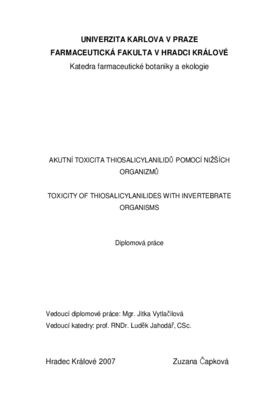Akutní toxicita thiosalicylanilidů pomocí nižších organizmů
Toxicity of thiosalicylanilides with invertebrate organisms
diploma thesis (DEFENDED)

View/
Permanent link
http://hdl.handle.net/20.500.11956/10717Identifiers
Study Information System: 17772
Collections
- Kvalifikační práce [6725]
Author
Advisor
Referee
Macáková, Kateřina
Faculty / Institute
Faculty of Pharmacy in Hradec Králové
Discipline
Pharmacy
Department
Department of Pharmaceutical Botany and Ecology
Date of defense
4. 6. 2007
Publisher
Univerzita Karlova, Farmaceutická fakulta v Hradci KrálovéLanguage
Czech
Grade
Excellent
Thiosalicylanilidy jsou významné, biologicky aktivní látky. Dlouhou dobu jsou používány pro svou anthelmintickou a antimykotickou aktivitu. V posledních letech se testují jako látky potenciálně účinné proti tuberkulóze. V diplomové práci je sledována toxicita nově syntetizovaných thiosalicylanilidů. Jelikož se jedná o látky velmi těžce rozpustné či prakticky nerozpustné ve vodě, osvědčil se v pokusech jako látka zprostředkující rozpouštění (kosolvent) dimethylsulfoxid. Jako screeningová metoda byl použit biotest s bezobratlým organismem Artemia franciscana. Testy byly vyhodnocovány po 24 hodinách a z výsledků byla vypočtena hodnota EC50. Tato metoda je rychlá, finančně nenáročná a vhodná pro pre-screeningové hodnocení toxicity. Pořadí toxicity sledovaných látek bylo následující: 4'- brom - 3,5- dichlorthiosalicylanilid (13e) > 3, 4', 5-trichlorthiosalicylanilid (13b) > 3', 4'- dichlorthiosalicylanilid (8c) > thiosalicylanilid (8a) > 5 - chlorthiosalicylanilid (12a) > 4'- methylthiosalicylanilid (8i).
Thiosalicylanilides are important biologically active substances. They have been used for they anthelmintic and antifungal activity for a long time. In recent years they were tested as substances potentially effective in the therapy of tuberculosis. This Diploma-Study presents the toxicity of newly synthesized thiosalicylanilides. As these substances are hardly soluble or practically insoluble in water, dimethylsulfoxide was succesful as a co-solvent in the experiments. The Artemia franciscana biotest was used as a screening method. These experiments were evaluated after a 24hours period and the EC50 values were calculated. This method is rapid, inexpensive and convenient for pre-screening toxicity tests. The toxicity order for the tested compounds was: 4' - bromo - 3,5 - dichlorothiosalicylanilide (13e) > 3,4',5 - trichlorothiosalicylanilide (13b) > 3', 4'- dichlorothiosalicylanilide (8c) > thiosalicylanilide (8a) > 5 - chlorothiosalicylanilide (12a) > 4'- methylthiosalicylanilide (8i).
